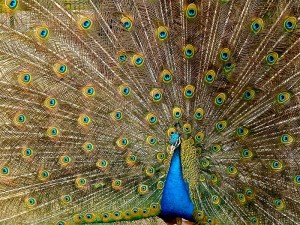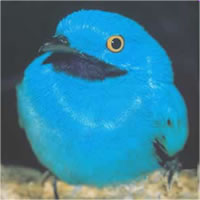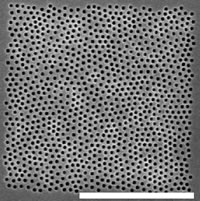![AGELESS BRILLIANCE: Although the pigment-derived leaf color of this decades-old specimen of the African perennial Pollia condensata has faded, the fruit still maintains its intense metallic-blue iridescence.COURTESY OF P.J. RUDALL [downloaded from http://www.the-scientist.com/?articles.view/articleNo/34200/title/Color-from-Structure/]](http://www.frogheart.ca/wp-content/uploads/2013/02/AgelessColour_-Pollia_condensata_Herbarium2-300x254.jpg)
AGELESS BRILLIANCE: Although the pigment-derived leaf color of this decades-old specimen of the African perennial Pollia condensata has faded, the fruit still maintains its intense metallic-blue iridescence.COURTESY OF P.J. RUDALL [downloaded from http://www.the-scientist.com/?articles.view/articleNo/34200/title/Color-from-Structure/]
Here are a few excerpts from the piece,
Colors may be evolution’s most beautiful accident. Spontaneous mutations that perturbed the arrangement of structural components, such as cellulose, collagen, chitin, and keratin, inadvertently created nanoscale landscapes that catch light in the most vibrantly diverse ways—producing iridescent greens, fiery reds, brilliant blues, opalescent whites, glossy silvers, and ebony blacks.
Structural colors, in contrast to those produced by pigments or dyes, arise from the physical interaction of light with biological nanostructures. These color-creating structures likely developed as an important phenotype during the Cambrian explosion more than 500 million years ago, when organisms developed the first eyes and the ability to detect light, color, shade, and contrast. “As soon as you had visual predators, there were organisms that were either trying to distract, avoid, or communicate with those predators using structural coloration,” says Yale University evolutionary ornithologist Richard Prum.
Ever since, structural coloration has evolved multiple times across the tree of life, as a wide range of organisms developed ways to fine-tune the geometry of some of the most abundant (and often colorless) biomaterials on Earth, engineering grooves, pockets, and films that scatter light waves and cause them to interfere with each other in ways we humans happen to find aesthetically pleasing.
Here’s why color derived from structure doesn’t fade, from Luiggi’s article,
Pigments and dyes are molecules that produce colors by the selective absorption and reflection of specific wavelengths of electromagnetic radiation. Structural colors, on the other hand, rely exclusively on the shape of the material and not its chemical properties. While pigments and dyes degrade and their colors fade over time, some types of structural coloration, which rely on the same materials that make up tree bark, insect exoskeletons, and claws or nails, can persist hundreds, thousands, and even millions of years after the death of the organism.
Structural color can be found in a lot of plant life,
Although there are only a handful of known examples of structural colors in fruits, there are plenty to be found in the leaves and petals of plants. Within every family of flowering plants, there is at least one species that displays structural colors.
“The presence of structural colors, especially in flowers, is likely used by pollinators to spot the position of the flower and to recognize it better,” Vignolini [Silvia Vignolini, a physics postdoc at the University of Cambridge] explains. But in some plants, the evolutionary purpose of structural coloration is harder to pin down. The leaves of the low-lying tropical spikemoss Selaginella willdenowii, for example, produce blue-green iridescence when young and growing in the shade, and tend to lose the structural coloration with age and when exposed to high levels of light. The iridescence is achieved by cells in the leaves’ upper epidermis, which contain a few layers of cellulose microfibrils packed with different amounts of water. This ultrastructure is often absent in the leaves of the same species growing in direct sunlight. Researchers hypothesize that the spikemoss turns off its iridescence by changing the water content of the leaves’ cell walls, says Heather Whitney, a research fellow at the University of Bristol who studies iridescence in plants.
This capability is not limited to plants. Insects (jewel beetles and the morpho butterfly are often cited) and fish also have evolved to include structural color as protective or attractive devices, from Luiggi’s article,
The brightest living tissues on the planet are found in fish. Under ideal conditions, for example, the silvery scales of the European sardine and the Atlantic herring can act like near-perfect mirrors—reflecting up to 90 percent of incoming light. It is an irony of nature that these shiniest of structures are not meant to be flaunted, but are intended as camouflage.
“When you’re out in the open water, if you drop down below 10 to 30 meters, in any direction you look, the intensity of light is the same,” explains Nicholas Roberts, a physicist at the University of Bristol who specializes in bio-optics. At that depth, a perfect reflector, or mirror, would seem invisible, because light is equally reflected from all sides and angles.
It will be interesting to see if there’s any future discussion of the giant squid in the context of structural color since, according to very recent research (as per my Feb. 1, 2013 posting), it appears to be covered in gold leaf when observed in its habitat.
Luiggi’s article starts with an ornithologist and circles back in a discussion about the difficulty of creating nanostructures, soft matter condensed physics, and birds,
To create structural colors, organisms must master architecture at the nanoscale—the size of visible-light wavelengths. “But it turns out that biology doesn’t do a good job of creating nanostructures,” Prum says.
Instead, organisms create the initial conditions that allow those nanostructures to grow using self-organizing physical processes. Thus, organisms exploit what’s known as soft condensed matter physics, or “the physics of squishy stuff,” as Prum likes to call it. This relatively new field of physics deals with materials that are right at the boundaries of hard solids, liquids, and gases.
“There’ve been huge advances in this field in the last 30 years which have created rich theories of how structure can arise at the nanoscale,” Prum says. “It has been very applicable to the understanding of how structural colors grow.”
Soft condensed matter physics has been particularly useful in understanding the production of the amorphous nanostructures that imbue the feathers of certain bird species with intensely vibrant hues. The blue color of the male Eastern bluebird (Sialia sialis), for example, is produced by the selective scattering of blue light from a complex nanostructure of b-keratin channels and air pockets in the hairlike branches called feather barbs that give the quill its lift. The size of the air pockets determines the wavelengths that are selectively amplified.
While there’s better understanding of the mechanisms involved in structural color, scientists are a long way from replicating the processes, from the article,
“The three-dimensional nature of the structures themselves is just so complex,” says Vukusic. [physicist Peter Vukusic, a professor of natural photonics at the University of Exeter, UK] “Were it to be a simple periodic system with a regular geometry, you could easily put that into a computer model and run simulations all day. But the problem is that they are never perfectly periodic.”
This article is open access so, as I noted earlier, all you need is the time. As of my Feb. 6, 2013 posting, there was some new research announced about scientists making observations about the structural color in peacock feathers and applying some of those ideas to develop better resolution in e-readers.


